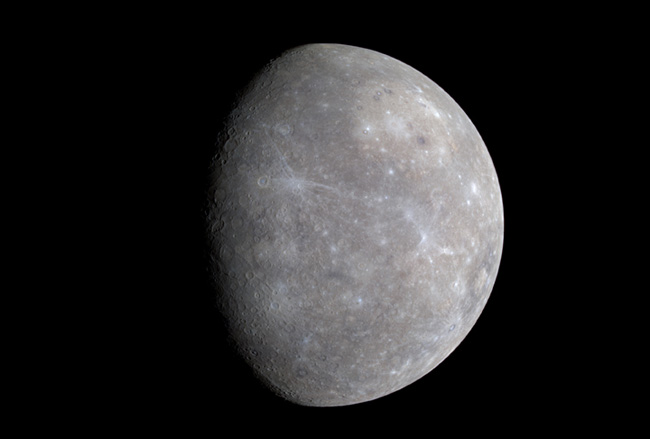Spacecraft Set to Swing by Mercury

A space probe is headed for a second swing past Mercury topick up a gravitational boost and eventually become the first spacecraft to orbitthe closest planet to our sun.
Scientists expect to get more than 1,200 pictures when NASA'sMESSENGER spacecraft zips past Mercury early Monday, which would help reveal mostof planet?s remaining unmapped terrain. The flyby should also provide a gravityassist that will prepare MESSENGER to enter orbit around Mercury in March 2011.
"For needles with smaller and smaller eyes, this teamis getting better and better," said Sean Solomon, MESSENGER's principalinvestigator at the Carnegie Institution of Washington, during a Wednesdayteleconference. He described the maneuvers as a "threading exercise"requiring the highest precision.
MESSENGER, short for the bulky name MErcury Surface, Space ENvironment,GEochemistry, and Ranging, should pass 125 miles (200 km) above Mercury, orroughly the same as the separation distance during afirst flyby on Jan. 14. Its cameras and instruments will cover 30 percentof the planet surface, including never-before-seen areas on the western side ofthe planet opposite to the first flyby's coverage.
No spacecraft has caught such close looks at the planetsince NASA's Mariner 10 probe, which zipped by Mercury three times in 1974 and1975.
The earlier Mariner probe managed to map just 45 percent ofthe planet's surface during its threeflybys, while MESSENGER scoped out half of the planet's unchartedsurface during its first flyby.
However, MESSENGER still needs to perform an intricate dancewith Mercury before it can turn full-time photographer. Each flyby requiresprecise earlier adjustments to the spacecraft's course that normally use upprecious onboard propellant.
Get the Space.com Newsletter
Breaking space news, the latest updates on rocket launches, skywatching events and more!
Mission planners skirted this issue and saved up morepropellant for the spacecraft's later mission by taking advantage of the solarwind.
"MESSENGER is first interplanetary mission to use solarsailing as a means to control its trajectory," said Daniel O'Shaughnessy, thelead MESSENGER navigator at Johns Hopkins University Applied Physics Laboratoryin Laurel, Md. He added that they achieved accuracy within a third of a mile (1km) using "only the subtle push of sunlight and without a single drop ofpropellant in over six months."
The spacecraft will begin its 15,000 mph (24,140 kph) flybyin the early morning hours of U.S. EDT on Monday, Oct. 6. Its team willoccasionally lose contact as MESSENGER turns this way and that to take picturesand compile seven large image mosaics of the planet surface. The closest approachduring the roughly 30-hour encounter is set for about 4:45 a.m. EDT (0845 GMT).
A 17-minute power outage will occur as MESSENGER passes intoMercury's shadow, requiring the spacecraft to rely on internal batteriesinstead of its solar panels.
The first MESSENGER flyby found evidence that volcanoesand not impacts had created Mercury's flat, smooth plains. It also showedthat Mercury's magnetic field is elongated like a tear drop, with the solarwind pushing against the side closest to the sun and pressing it close to thesurface.
MESSENGER approaches its upcoming flyby as an experiencedplanetary hopper, having revisitedEarth once and swung by Venus twice since its August 2004 launch. A thirdflyby of Mercury is also scheduled for Sept. 2009, before the spacecraft entersorbit in 2011.
- Video - Mysterious Metallic Mercury
- Top 10 New Mysteries of Mercury
- Video - MESSENGER Probe Views Earth in Flyby
Join our Space Forums to keep talking space on the latest missions, night sky and more! And if you have a news tip, correction or comment, let us know at: community@space.com.
Jeremy Hsu is science writer based in New York City whose work has appeared in Scientific American, Discovery Magazine, Backchannel, Wired.com and IEEE Spectrum, among others. He joined the Space.com and Live Science teams in 2010 as a Senior Writer and is currently the Editor-in-Chief of Indicate Media. Jeremy studied history and sociology of science at the University of Pennsylvania, and earned a master's degree in journalism from the NYU Science, Health and Environmental Reporting Program. You can find Jeremy's latest project on Twitter.









